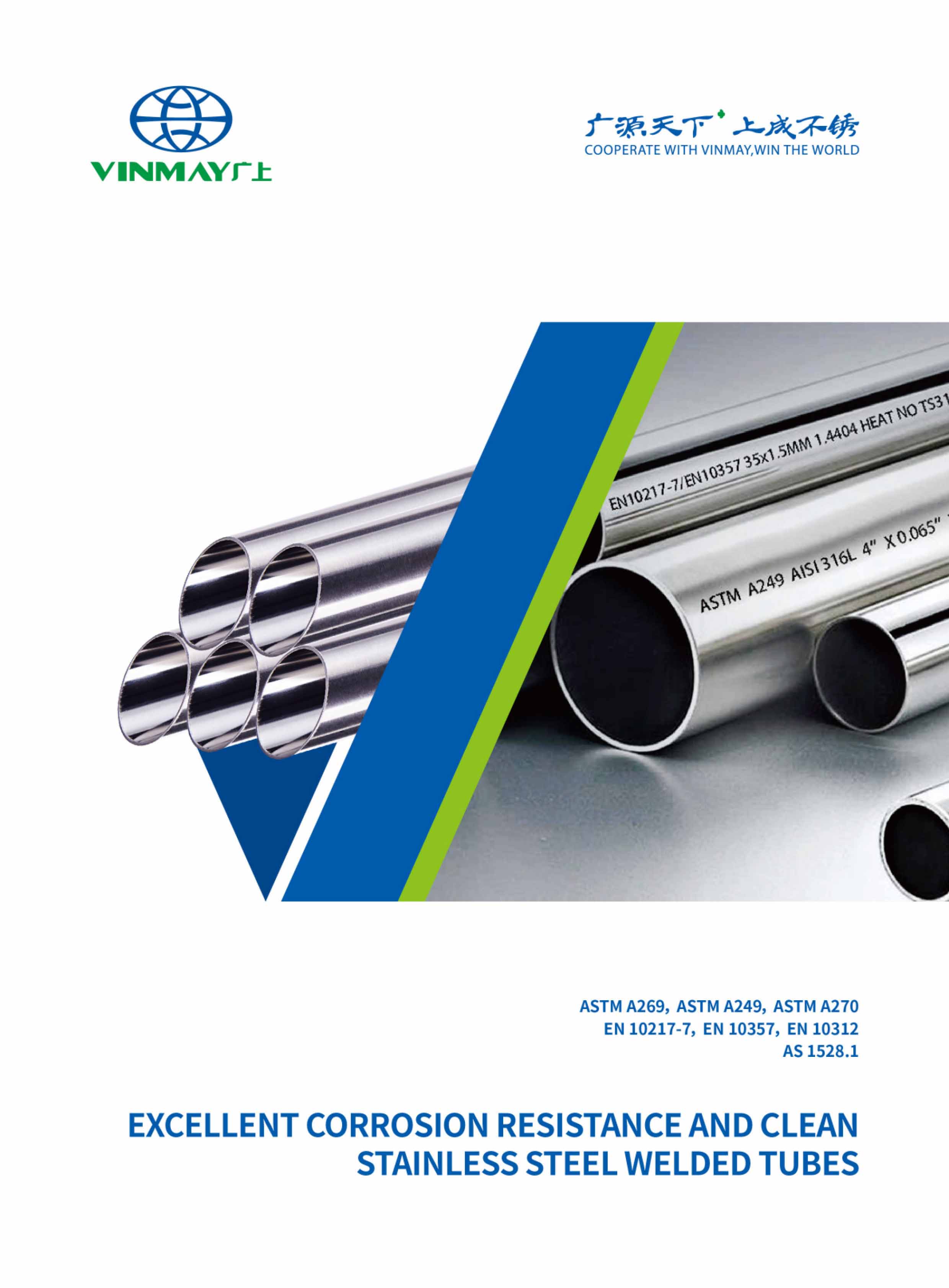Standard stainless steel tube sizes are vital to numerous industrial applications, offering a reliable framework for ensuring system compatibility and performance. These sizes, defined by the outside diameter (OD), inside diameter (ID), and wall thickness, adhere to stringent standards established by organizations such as ASTM and ISO. This adherence guarantees uniformity and reliability, essential for maintaining system integrity, especially in high-pressure environments. Understanding these standard dimensions is crucial for making informed decisions regarding material selection and system design. But how do these standardized sizes influence the overall efficiency and safety of your applications?
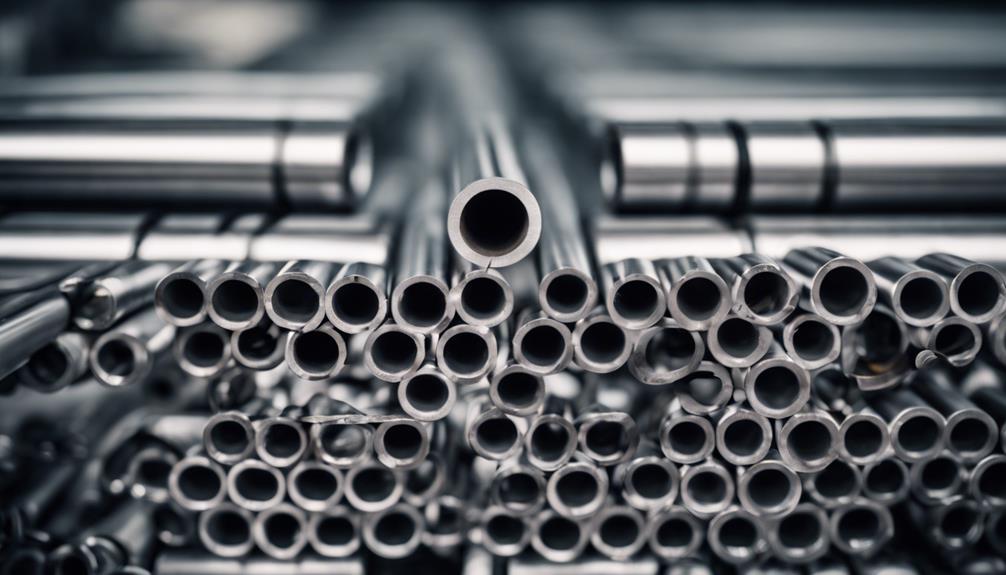
Standard stainless steel tube size classifications are essential for ensuring compatibility and performance in various applications. These classifications include precise measurements of Outside Diameter (OD), Inside Diameter (ID), Wall Thickness, Length, Nominal Pipe Size (NPS), and Schedule.
Each parameter is critical for determining the tube's structural integrity and suitability for specific industrial requirements.
Outside Diameter (OD) is the measurement of the distance across the outer surface of the tube. Accurate measurement of the outside diameter (OD) is crucial for guaranteeing the proper fit and performance of stainless steel tubes in a variety of applications. Utilizing precise OD measurement techniques such as calipers or micrometers guarantees that the tubing meets stringent specifications. The OD accuracy and precision directly influence the compatibility of the tubes with connectors, couplings, and other components, making it a critical factor in system and equipment design.
Many stainless steel tubing manufacturers provide OD customization options to cater to unique application requirements. Custom fabrication services enable the tailoring of the OD to specific needs, ensuring ideal fit and function.
The OD impact on tubing strength is significant, as it, along with wall thickness, determines the structural integrity and ability to withstand pressures and loads. Selecting the correct OD is crucial to ensuring the tubing's durability and performance in demanding conditions.
Here's a table outlining the common standard sizes of stainless steel tubes, categorized by small, medium, and large diameters:
| Category | OD (mm) | OD (inches) | Typical Wall Thickness (mm) | Applications |
|---|---|---|---|---|
| Small Diameter | 6 | 0.25 | 0.5 - 1 | Medical devices, precision instrumentation, small-scale fluid systems |
| 10 | 0.375 | 1 - 1.5 | Laboratory equipment, hydraulic lines, small structural components | |
| 12 | 0.5 | 1 - 2 | Small machinery, decorative elements, compact fluid systems | |
| Medium Diameter | 25 | 1 | 1.5 - 3 | Structural applications, support columns, mid-sized fluid transport systems |
| 38 | 1.5 | 2 - 4 | Handrails, machinery framework, medium-sized piping systems | |
| 50 | 2 | 2.5 - 5 | Larger structural components, industrial piping, mechanical supports | |
| Large Diameter | 76 | 3 | 3 - 6 | Heavy-duty structural supports, large-scale fluid transport, industrial applications |
| 100 | 4 | 4 - 8 | Major piping systems, chemical processing, substantial structural frameworks | |
| 150 | 6 | 5 - 10 | High-capacity transport systems, major structural components, heavy-duty industrial applications |
Understanding and controlling these variables allows for superior performance and reliability in stainless steel tubing applications.
The Inside Diameter (ID) is the internal measurement of a tube from one inner wall to the opposite inner wall, excluding the thickness of the tube walls. Understanding the exact measurement and control of the inside diameter (ID) is necessary for ensuring ideal flow rates and compatibility with fittings in stainless steel tubing applications. Accurate ID measurement techniques are crucial, often employing bore gauges, calipers, and micrometers to deliver precision within accepted tolerance levels. These tools guarantee that the internal dimensions meet stringent specifications, important for maintaining system integrity.
The ID's impact on the flow rate cannot be overstated. A precise ID ensures optimal fluid dynamics, vital for applications requiring exact flow rates, such as in chemical processing or hydraulic systems. Equally important, ID and fitting compatibility must be meticulously managed to prevent leaks and ensure a secure connection, especially in high-pressure environments.
In instrumentation, the ID's accuracy is essential for the correct operation of sensors and other measuring devices, where even minor deviations can lead to significant errors. Additionally, specific tooling requirements often depend on the ID, necessitating exact measurements for the proper functioning of tools and equipment used within the tubing.
Wall thickness refers to the distance between the outer and inner surfaces of a tube. It is measured perpendicular to the stainless steel tube’s axis and is a critical parameter that influences the tubing's mechanical properties, such as strength, durability, and resistance to pressure and environmental conditions. The correlation between wall thickness and strength is significant; thicker walls generally provide enhanced structural integrity and superior resistance to external pressures.
Conversely, the impact of wall thickness on weight distribution is equally paramount, as increased wall thickness results in heavier tubing, which can affect the overall weight and balance of the system.
In selecting wall thickness, a critical consideration is the trade-off between flexibility and rigidity. Thin-walled tubing offers advantages such as reduced weight, increased flexibility, and improved heat transfer efficiency. However, it may also present disadvantages, including susceptibility to deformation and lower pressure resistance.
On the other hand, heavy wall tubing applications and benefits include enhanced durability, higher pressure ratings, and increased structural support, making it suitable for demanding environments, such as those involving water transport and distribution.
Key considerations include:
These factors ensure that the selected stainless steel tubing meets the stringent demands of its intended application.
The length of a stainless steel tube is the measurement from one end of the tube to the other along its axis and it dictates the amount of tube available for use in an application. Stainless steel tubes come in a variety of lengths to accommodate different industrial requirements, ensuring compatibility with various applications and system configurations. Standard lengths often include increments such as 6 meters or 20 feet, but custom lengths can be ordered to meet specific project needs. These length options enable precise alignment and integration into larger systems, enhancing both functionality and efficiency.
Accurate tube length is essential for ensuring proper fit and installation within a system or structure, as incorrect lengths can lead to installation difficulties and operational issues, with tools like tape measures or laser distance meters used to achieve precise results. Additionally, selecting the right length helps optimize cost efficiency by minimizing material waste and reducing the need for additional labor and cutting. In applications like fluid transport or structural support, the length directly impacts performance and efficiency, ensuring that the tube operates as intended within its system.
The cutting methods employed to achieve the desired tube lengths include mechanical sawing, laser cutting, and abrasive cutting, each offering distinct advantages in terms of accuracy and edge quality. Proper cutting techniques are imperative to maintain the tube's integrity and to prevent compromising its corrosion resistance properties.
By understanding the importance of tube length and its impact, you can make informed decisions when selecting stainless steel tubes. Accurate measurement and selection of length are crucial for ensuring the tube’s fit, performance, and cost-efficiency in your projects.
Nominal Pipe Size (NPS) and Schedule classifications are critical in defining the dimensions and wall thickness of stainless steel tubes, guaranteeing they meet specific industrial standards and performance requirements. NPS variations refer to the standardized nominal diameters of pipes, which do not necessarily reflect the actual external or internal diameters. This system allows for uniformity across different applications and industries.
Schedule differences, on the other hand, indicate the wall thickness of the pipe. The higher the schedule number, the thicker the wall, impacting both the pipe's pressure rating and weight.
Metric equivalents are often used alongside NPS to provide a global standard, facilitating international trade and application. Understanding these equivalents ensures precise matching and compatibility in diverse operational environments.
Weight calculations are critical for logistics, installation, and structural integrity analyses, as they directly correlate to the pipe's material volume and density.
Lastly, the inherent corrosion resistance of stainless steel, influenced by its alloy composition and wall thickness, is crucial for applications in harsh environments, ensuring longevity and reliability.
| NPS (inches) | OD (inches) | Schedule | WT (inches) | ID (inches) |
|---|---|---|---|---|
| 1/8 | 0.405 | 40 | 0.068 | 0.269 |
| 1/4 | 0.540 | 40 | 0.088 | 0.364 |
| 3/8 | 0.675 | 40 | 0.091 | 0.493 |
| 1/2 | 0.840 | 40 | 0.109 | 0.622 |
| 3/4 | 1.050 | 40 | 0.113 | 0.824 |
| 1 | 1.315 | 40 | 0.133 | 1.049 |
| 1 1/4 | 1.660 | 40 | 0.140 | 1.380 |
| 1 1/2 | 1.900 | 40 | 0.145 | 1.610 |
| 2 | 2.375 | 40 | 0.154 | 2.067 |
| 2 1/2 | 2.875 | 40 | 0.203 | 2.469 |
| 3 | 3.500 | 40 | 0.216 | 3.068 |
| 4 | 4.500 | 40 | 0.237 | 4.026 |
| 6 | 6.625 | 40 | 0.280 | 6.065 |
| 8 | 8.625 | 40 | 0.322 | 8.071 |
| 10 | 10.750 | 40 | 0.365 | 10.020 |
| 12 | 12.750 | 40 | 0.375 | 12.000 |
| 14 | 14.000 | 40 | 0.375 | 13.250 |
| 16 | 16.000 | 40 | 0.375 | 15.250 |
| 18 | 18.000 | 40 | 0.375 | 17.250 |
| 20 | 20.000 | 40 | 0.375 | 19.250 |
| 24 | 24.000 | 40 | 0.500 | 23.000 |
These are some common sizes and schedules for stainless steel tubes and pipes. The actual dimensions can vary depending on the specific standards and manufacturing tolerances.
Click to Download the Standard Stainless Steel Tube Sizes Chart PDF.
The standardization of stainless steel tube sizes is primarily governed by ASTM and ISO standards. These stainless steel tube standards provide detailed specifications to guarantee uniformity and reliability in applications. ASTM standards, specifically ASTM A213 and ASTM A269, outline requirements for dimensions, mechanical properties, and material composition.
Complementarily, ISO standards such as ISO 1127 define international criteria, guaranteeing consistency across global markets.
ASTM standards, such as ASTM A213 and ASTM A269, provide rigorous specifications for stainless steel tube sizes, ensuring consistent quality and performance in industrial applications. These standards facilitate precise ASTM standards comparison, offering clear guidelines for material properties, dimensions, and tolerances.
An overview of stainless steel grades reveals that ASTM standards cover various grades, each with distinct corrosion resistance properties and mechanical characteristics. For instance, ASTM A213 outlines seamless ferritic and austenitic alloy steel boiler, superheater, and heat exchanger tubes, while ASTM A269 specifies general service seamless and welded austenitic stainless steel tubes.
Heat treatment effects are critical in achieving desired mechanical properties and corrosion resistance. ASTM standards delineate specific heat treatment protocols to optimize outcomes. Additionally, welding techniques & challenges are addressed, ensuring that tubes meet stringent requirements for integrity and durability in diverse environments.
Understanding ASTM standards empowers professionals to make informed decisions, ensuring control over material selection and application success.
How do ISO standards guarantee uniformity and precision in stainless steel tube sizes for global applications? ISO standards ensure that stainless steel tubes meet stringent specifications, facilitating seamless international trade and manufacturing. These standards provide a consistent framework for metric conversions, tolerance levels, corrosion resistance, welding techniques, and surface finish.
ISO standards specify precise dimensions, enabling manufacturers to produce tubes with exact outer diameters (OD), wall thicknesses, and lengths. The controlled tolerance levels guarantee minimal deviations, enhancing compatibility and performance in various applications. Below is a table illustrating typical ISO standard dimensions for stainless steel tubes:
| Outer Diameter (mm) | Wall Thickness (mm) | Length (m) |
|---|---|---|
| 10 | 1.0 | 6 |
| 25 | 1.5 | 6 |
| 50 | 2.0 | 6 |
ISO standards also emphasize corrosion resistance, essential for maintaining the integrity of stainless steel tubes in aggressive environments. Additionally, these standards provide guidelines on welding techniques, ensuring structural soundness and longevity of welded joints. Surface finish criteria are defined to achieve desired smoothness, reducing the risk of contamination and enhancing aesthetic appeal.
Beyond ISO standards, various other standards such as ANSI and ASME play a significant role in defining stainless steel tube sizes for diverse industrial applications. These standards guarantee consistency, reliability, and compatibility across different sectors and international markets.
ANSI (American National Standards Institute) and ASME (American Society of Mechanical Engineers) provide guidelines that specify the dimensions, tolerances, and performance criteria for stainless steel tubes. These standards accommodate both metric equivalents and imperial measurements, facilitating international variations in manufacturing and application.
Key elements in these standards include:
In examining specific types of stainless steel tubing, it is essential to address the precise dimensions associated with each form.
Stainless steel round tubes typically range from 0.25 inches to 8 inches in diameter, while rectangular and square tubing dimensions vary notably depending on wall thickness and application requirements.
Additionally, stainless steel sanitary tubing adheres to stringent specifications, often meeting ASTM A270 standards for use in hygienic environments.

Shop Stainless Steel Welded Round Tube
Stainless steel round tubes, available in materials such as 201, 304, 304L, 316L, and 430, range in size from 6mm to 219mm in diameter with thicknesses between 0.6mm and 5.0mm. These tubes are engineered through a meticulous manufacturing process that guarantees uniformity and precision. Their inherent corrosion resistance makes them ideal for various applications, including handrails, furniture, and machinery equipment.
Key considerations when selecting stainless steel round tubes include:
These stainless steel round tubes are sourced from reputable suppliers such as Baosteel and Tisco Tsing Shan, guaranteeing high-quality raw materials. The products undergo strict quality control, including mirror polishing up to four times and rigorous thickness and diameter specifications. This guarantees that each polished stainless steel round tube meets the precise needs of the customer, enhancing both performance and aesthetic appeal.
With extensive certifications like ISO, AEO, and MTC, customers can trust the reliability and durability of these stainless steel round tubes for sale.

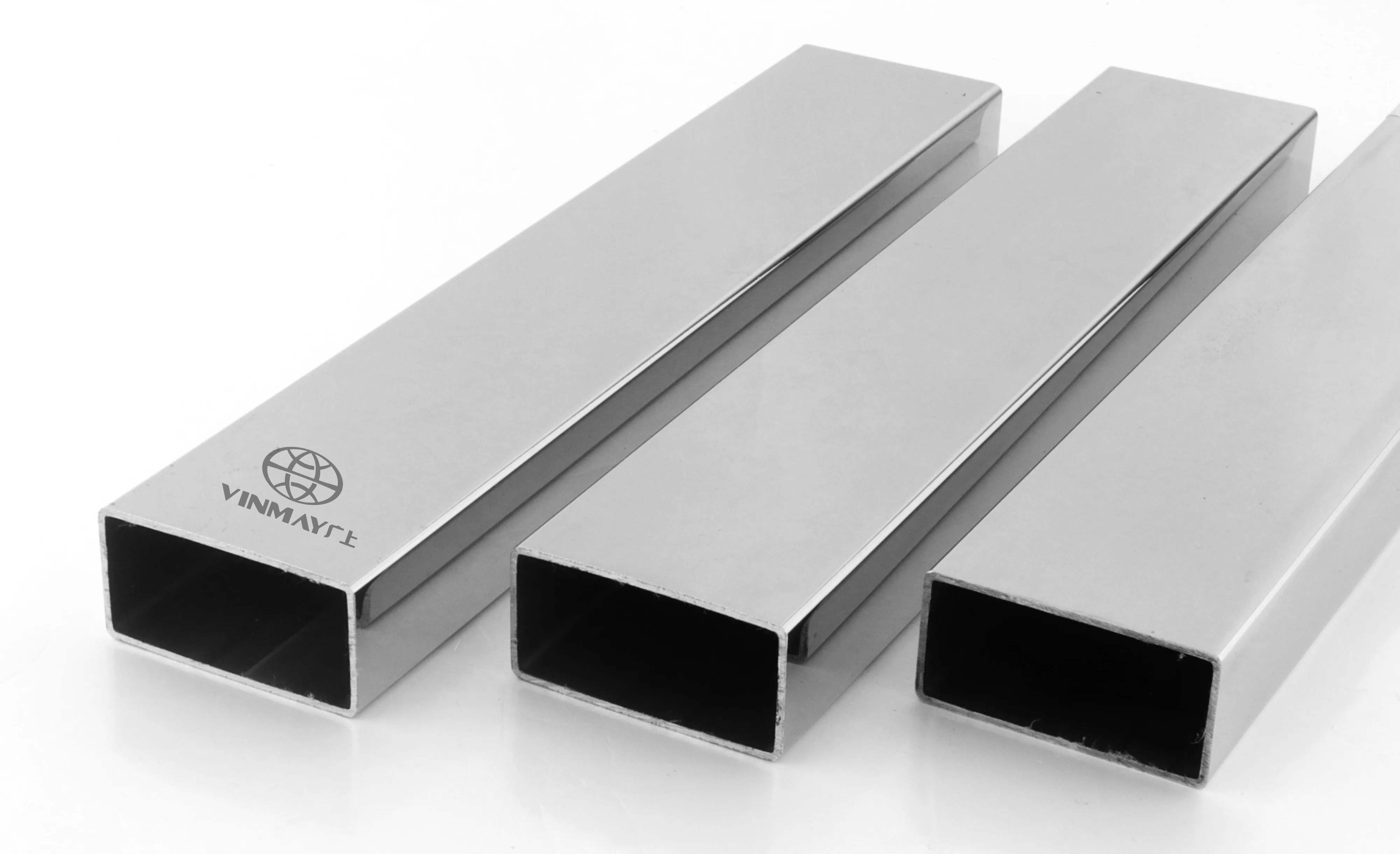
View Stainless Steel Rectangular Tube
Rectangular stainless steel tubes, available in materials such as 201, 304, 304L, 316L, and 430, come in sizes ranging from 10x10mm to 150x150mm with thicknesses between 0.6mm and 5.0mm. The manufacturing process involves precision welding techniques that guarantee uniform wall thickness and smooth surface finishes, enhancing their corrosion resistance.
These tubes are produced with strict adherence to ISO, AEO, MTC, and PED certifications, ensuring high-quality standards.
For structural applications, rectangular stainless steel tubing offers superior weight distribution, making it ideal for frameworks and support structures. The material choice, such as 316L, provides excellent corrosion resistance, critical for environments exposed to moisture and chemicals.
The tubes' dimensions and tolerances are stringently controlled to meet specific requirements, including max radii of corners and outside diameter tolerances, thereby securing reliability and consistency in performance.
Surface finishes range from mill finish to mirror finish, catering to various aesthetic and functional needs. Utilizing raw materials from reputable suppliers like Baosteel and Tisco Tsing Shan further secures durability and strength.
These features collectively make rectangular stainless steel tubing a versatile and dependable choice for industrial and architectural applications.

Explore Stainless Steel Square Tube
Building upon the precision and versatility of rectangular tubing, square stainless steel tubes are similarly produced in a range of dimensions, typically from 10x10mm to 150x150mm, with wall thicknesses between 0.6mm and 5.0mm, and are available in grades such as 201, 304, 304L, 316L, and 430. These stainless steel square tubes are engineered for diverse structural applications, offering superior corrosion resistance and a variety of surface finishes to meet specific project requirements. For those considering project budgets, it's important to evaluate the cost of stainless steel square tubing, which can vary based on size, grade, and finish.
The manufacturing process of these tubes involves advanced welding techniques that secure durability and integrity, essential for high-stress environments. Custom fabrication options allow for tailored solutions that adhere to precise specifications, enhancing the control and adaptability for various industrial needs.
For more detailed information on maintaining your stainless steel square tubing, refer to our stainless steel square tubing maintenance guide.
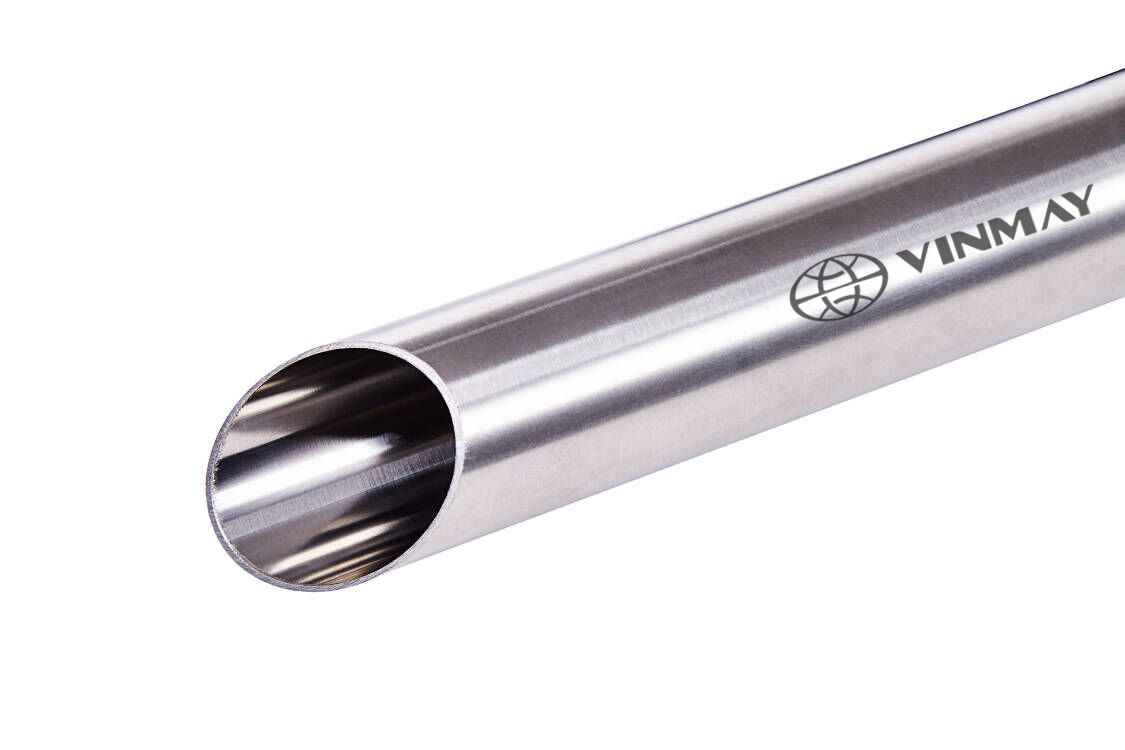
Browse Stainless Steel Sanitary Tube
Leveraging top-notch materials and engineering precision, sanitary stainless steel tubing is meticulously designed to meet strict industry standards, offering dimensions that typically range from 1/2 inch to 8 inches in diameter with wall thicknesses from 0.065 inches to 0.120 inches. These hygienic stainless steel tubes are essential in industries such as food and beverage, pharmaceuticals, and biotechnology due to their excellent surface finish and best material composition.
| Specification | Details | Importance |
|---|---|---|
| Surface finish | 20-30 Ra microinches | Ensures smooth, cleanable surfaces to prevent contamination |
| Pressure ratings | Up to 2500 psi | Determines suitability for high-pressure applications |
| Temperature limits | -325°F to 1500°F | Defines operational range for various environments |
| Corrosion resistance | High | Enhances durability and longevity in harsh conditions |
| Tube bending | 1D to 5D bends | Facilitates complex piping systems |
| Welding techniques | TIG, MIG | Ensures strong, leak-proof joints |
| Cleaning procedures | CIP, SIP | Maintains hygiene and operational efficiency |
Sanitary tubing's corrosion resistance and durability make it ideal for environments demanding high purity and cleanliness. Advanced tube bending and sanitary stainless steel welding techniques enable precise configurations, while rigorous cleaning procedures and maintenance tips, such as using CIP (Clean-In-Place) or SIP (Sterilize-In-Place) systems, guarantee sustained performance.
Selecting the appropriate stainless steel tube size involves evaluating key factors such as application requirements, mechanical properties, and dimensional tolerances. Understanding these variables ensures that the chosen tube size meets both performance and cost-efficiency benchmarks.
Dimensional considerations are paramount. Evaluate the tube's inner and outer diameters, wall thickness, and length to ensure precision manufacturing and adherence to stringent application requirements. For instance, high-pressure applications necessitate thicker walls to withstand operational stresses.
Material compatibility is essential to prevent corrosion and guarantee long-term durability. Assess the chemical composition of the stainless steel to match it with the environmental conditions and operational fluids it will encounter. This step guarantees the material will perform optimally and resist degradation.
Application requirements should dictate the mechanical properties needed, such as tensile strength and hardness. Ensuring the tube meets these specifications contributes to reliable and safe performance in its designated role.
Cost-effective options must be considered to balance budget constraints with quality requirements. Investigate various grades and suppliers to find the most economically viable solution without compromising on essential characteristics.
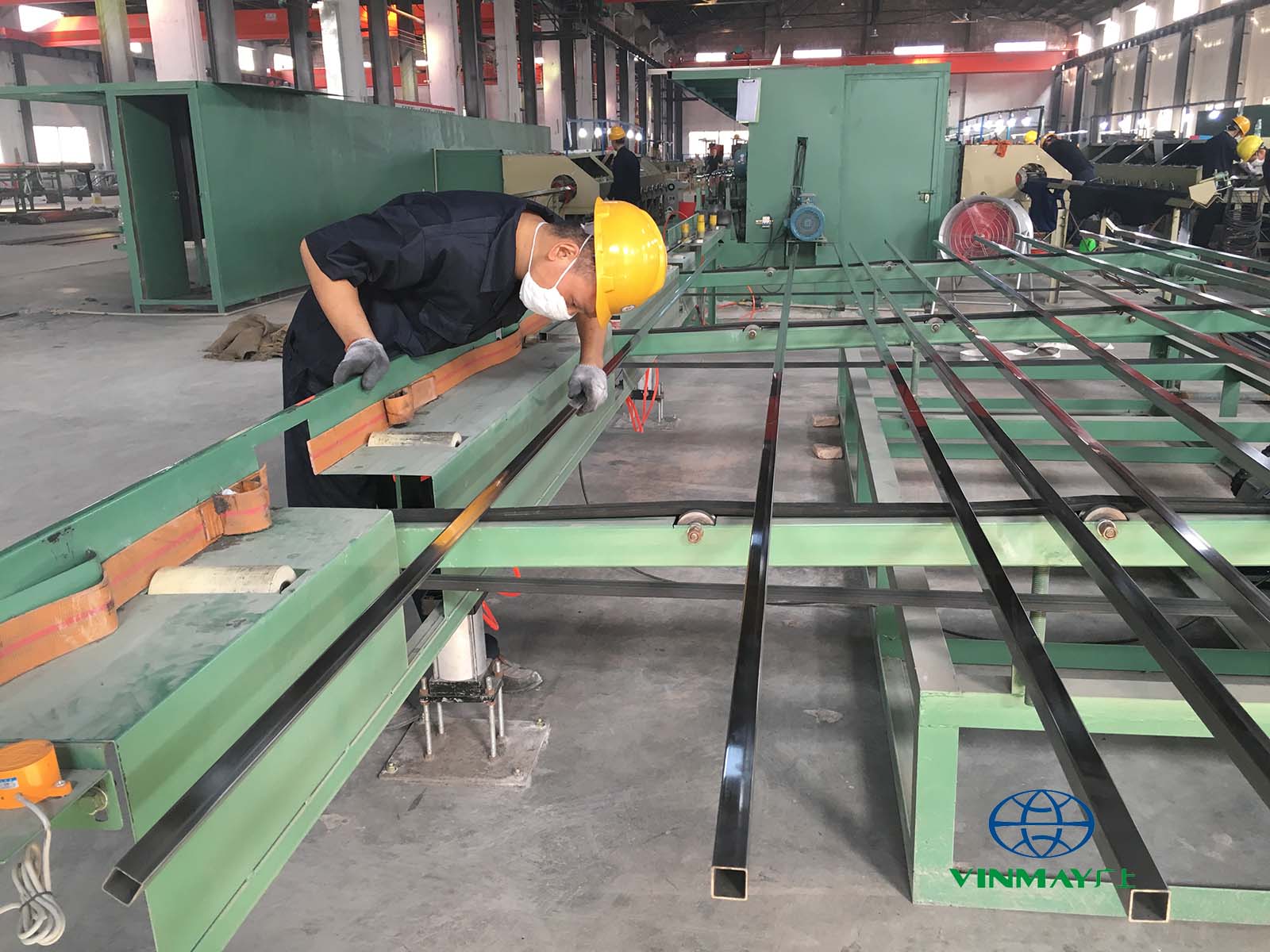
Evaluating the correct stainless steel tube size is only part of the process; when purchasing stainless steel tubes, it is essential to assess supplier reliability, quality certifications, and adherence to industry standards to guarantee the best performance and compliance.
Material selection is paramount; make sure the chosen alloy meets the specific mechanical and chemical requirements of your application. Special attention should be given to corrosion resistance properties, especially if the tubes will be used in harsh or corrosive environments.
Welding considerations are another vital factor. Stainless steel tubes must exhibit excellent weldability to accommodate any required joining processes. Confirm that the material's composition supports efficient welding techniques and adheres to stainless steel pipe welding standards without compromising the tube's structural integrity.
Cost factors are equally significant. While high-quality stainless steel may demand a higher initial investment, it often results in lower long-term maintenance costs and enhanced durability. Scrutinize cost structures to find a balance between upfront expenses and lifecycle performance.
For top-quality wholesale stainless steel tubes, trust Vinmay. Our products are backed by rigorous quality certifications and comply with industry standards to ensure superior performance and reliability. Contact us today to learn more about our range of stainless steel tubes and how we can meet your specific project needs.
Stainless steel tubes are extensively utilized in industrial uses, construction applications, the automotive industry, medical equipment, and aerospace engineering, owing to their corrosion resistance, high strength-to-weight ratio, and durability, ensuring the best performance and longevity.
Symbolizing a fortress against time, stainless steel tubing excels in corrosion resistance, offering unrivaled longevity benefits. Its superior strength properties and versatile applications, despite higher initial costs, often justify the investment when compared to alternative materials.
Read Also:
Stainless steel tubes require specific maintenance for best performance, including corrosion prevention, appropriate cleaning methods, regular material testing, maintaining surface finishes, and adhering to inspection requirements. These practices guarantee longevity and reliability in demanding applications.
Welding stainless steel tubes is like crafting a precise sculpture; advanced welding techniques and joining methods allow extensive customization options. Understanding material properties is essential for successful fabrication processes, ensuring the best performance and structural integrity of welded stainless steel tubes.
Temperature effects on stainless steel tubes greatly influence corrosion resistance, thermal expansion, and material strength. Elevated temperatures can alter welding techniques, necessitating careful control to maintain structural integrity and performance under varying thermal conditions.
To sum up, following standardized stainless steel tube sizes guarantees system integrity, compatibility, and performance, especially in high-pressure environments.
Consistency in measurements like outer diameter (OD), inner diameter (ID), and wall thickness, as regulated by ASTM and ISO standards, offers dependability and consistency across uses.
Selecting the right tube size, as directed by industry norms, avoids operational inefficiencies and potential hazards—indeed, 'a stitch in time saves nine' in choosing suitable stainless steel tubing.


